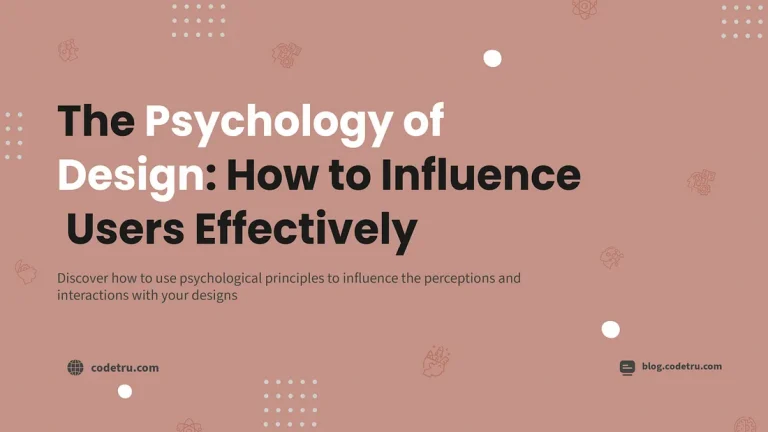A designer who doesn’t understand human psychology is going to be no more successful than an architect who doesn’t understand physics.
– Joe Leech
Design psychology: a new term for a principle we have been using for ages.
Why do you think you take actions on certain advertisements you see online or why you instantly feel important when entering a luxury store? The answer to these questions is hidden in the depths of human mind.
In the world of architecture, interior design, and space planning, there exists a field known as Design Psychology. This practice leverages the principles of psychology to shape spaces and designs that are not only visually appealing but also conducive to human well-being and functionality.
The psychology of design shares common ground and principles with several areas of psychology, each contributing unique insights to the art of design:
1. Human Factors Psychology
2. Environmental Psychology
Understanding how the environment affects human behavior and well-being is key in both environmental psychology and design psychology. Both fields seek to create spaces that promote positive emotional and cognitive responses.
3. Industrial-Organizational Psychology
While industrial-organizational psychology typically deals with workplace dynamics, Design Psychology can borrow principles related to motivation, productivity, and job satisfaction to enhance the design of office spaces.
So how does knowing your way around the human brain can help you create an ultimate user experience? Knowing certain principles and how the human mind perceives your design can help you create designs that are not only visually pleasing but also provide an
How Design Psychology Creates Intuitive User Experiences
1. Enhancing Usability
Design Psychology considers how users interact with spaces or products. For example, arranging furniture in a way that intuitively guides people through a room can improve usability.
2. Accessibility
Designing with inclusivity in mind ensures that spaces are accessible to all individuals, regardless of physical abilities. This can include ramps, wider doorways, and tactile cues or websites with minimal design with larger fonts for the visually impaired.
3. Aesthetics
Incorporating principles like symmetry and balance from neuroscience can result in visually pleasing environments that evoke positive emotions.
4. Emotional Responses
By employing color psychology, designers can choose colors that elicit specific emotions. Warm colors like red and orange can create a sense of excitement, while blues and greens promote calmness.
The Neuroscience of Design
The brain processes visual information very quickly. Within milliseconds of seeing something, the brain has already begun to interpret it. This process is influenced by several factors, such as the person’s attention, memory, and emotions.
-
Visual Processing: The brain processes visual information rapidly. Designers can use this knowledge to create clear and engaging visuals.
-
Perception and Attention: Using contrast and hierarchy in design can guide the viewer’s attention and enhance their perception of key elements.
-
Memory and Emotion: Design elements can trigger emotional responses and influence memory. For example, a cozy reading nook with soft lighting can create positive associations.
There are a number of principles of neuroscience that can inform design decisions:
Contrast: Contrast can be used to draw attention to important elements. For example, a dark button on a light background will be more noticeable than a light button on a light background.
Hierarchy: Hierarchy can be used to organize information in a logical way. For example, the most important information should be placed at the top of a page or at the beginning of a paragraph.
Symmetry and balance: Symmetry and balance can be used to create a sense of order and harmony. For example, a symmetrical layout will be more pleasing to the eye than an asymmetrical layout.
Gestalt laws: Gestalt laws are a set of principles that describe how the brain groups and interprets visual information. For example, the law of proximity states that objects that are close together are perceived as being grouped together.
Some ways you can apply neuroscience in design are:
-
Use colors, shapes, fonts, images, and animations that suit the purpose and context of the design.
-
Use contrast to draw attention to important elements.
-
Use hierarchy to organize information in a logical way.
-
Use symmetry and balance to create a sense of order and harmony.
Our brains play a vital role in how we perceive and interact with design elements. Understanding this relationship can inform design decisions:
Cognitive Psychology and Design
The mind interprets and interacts with design elements in a variety of ways. This interaction affects the person’s cognition, learning, problem-solving, and decision-making.
There are a number of principles of cognitive psychology that can inform design decisions:
-
Cognitive load: Cognitive load is the amount of mental effort required to perform a task. Designers should strive to minimize cognitive load by simplifying the design and reducing distractions.
-
Mental models: Mental models are the internal representations of how the world works. Designers should design products and services that are consistent with users’ mental models to make them easy to learn and use.
-
Schemas: Schemas are cognitive structures that organize knowledge and experience. Designers can use schemas to create designs that are familiar and intuitive for users.
-
Affordances: Affordances are cues that indicate how an object can be used. Designers can use affordances to make their designs easier to understand and use.
-
Feedback: Feedback is information that is provided to users about their actions. Designers can use feedback to help users learn and correct their mistakes.
The Social Psychology of Design
The purpose behind every design is to provide the users with an ultimate experience in your store or on your website and to prompt them to take actions. Design doesn’t exist on its own; it interacts with the social context and user behavior:
-
Social Proof: Showcasing social proof through user testimonials or reviews can build trust and credibility in your product or service.
-
Reciprocity and Incentives: Offering incentives or rewards can motivate desired behaviors, such as completing a purchase or signing up for a newsletter.
-
Creating a Sense of Community: Users will always trust other users over a company. Designing in a way that can foster a sense of belonging and community, can encouraging users to engage and return.
-
Scarcity: We always want to feel uniques, scarcity allows you to have exclusivity that you have always wanted.
Conclusion
In summary, Design Psychology harnesses the power of psychology to shape environments that enhance usability, accessibility, aesthetics, and emotional responses. By understanding the principles of neuroscience, cognitive psychology, and social psychology, designers can create spaces and products that resonate with users on a profound level. Design Psychology isn’t just about aesthetics; it’s about crafting experiences that improve our lives.
To delve deeper into this captivating field, explore resources such as books by Donald A. Norman and Richard Cytowic, who delve into the intersection of psychology and design. By embracing Design Psychology, we can create spaces and products that truly cater to the human psyche, elevating our experiences in the physical and digital worlds alike.
5 FAQs on Design Psychology
1. What is Design Psychology and how does it impact user experience?
Design Psychology is the application of psychological principles to the creation of design elements that enhance usability, aesthetics, and emotional responses. It involves understanding how users perceive and interact with spaces, products, and interfaces to create intuitive and engaging experiences. By leveraging insights from human factors psychology, environmental psychology, and cognitive psychology, designers can craft environments that improve user satisfaction and effectiveness.
2. How can understanding human factors psychology improve design?
Human factors psychology focuses on how people interact with products and environments. Understanding this field helps designers optimize layouts, controls, and features to enhance user comfort, safety, and efficiency. For instance, ergonomic design ensures that products are easy and comfortable to use, while intuitive interfaces reduce the learning curve for new users. Integrating these principles can lead to more user-friendly and effective designs.
3. What role does color psychology play in design?
Color psychology examines how different colors influence emotions and perceptions. In design, colors can be strategically chosen to evoke specific responses: warm colors like red and orange can create excitement, while cool colors like blue and green promote calmness. By applying color psychology, designers can enhance the emotional impact of their work and align it with the desired user experience.
4. How does neuroscience influence design decisions?
Neuroscience provides insights into how the brain processes visual information, attention, and memory. Designers use principles from neuroscience, such as contrast, hierarchy, and symmetry, to create clear and engaging visuals. Understanding how users perceive and respond to design elements allows designers to craft more effective and memorable experiences, ensuring that key information stands out and is easily retained.
5. What are some examples of applying cognitive psychology in design?
Cognitive psychology principles, such as cognitive load and mental models, guide designers in creating user-friendly products and interfaces. For example, minimizing cognitive load involves simplifying design to reduce mental effort and avoid overwhelming users. Designing in alignment with users’ mental models ensures that interactions are intuitive and consistent with their expectations. Additionally, providing clear feedback helps users learn and correct their actions efficiently.







